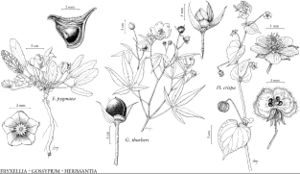Gossypium
Sp. Pl. 2: 693. 1753.
Gen. Pl. ed. 5, 309. 1754.
| Taxon | Illustrator ⠉ | |
|---|---|---|
 | Fryxellia pygmaea Gossypium thurberi Herissantia crispa | Linny Heagy Linny Heagy Linny Heagy |
Shrubs [trees], hairy or glabrate, not viscid. Stems erect [or procumbent]. Leaves: stipules persistent, subulate or linear to falcate; blade ovate, unlobed, shallowly lobed, or deeply parted, base subcordate or cordate, margins entire, surfaces glabrous or stellate-hairy, often with abaxial foliar nectaries. Inflorescences axillary, solitary flowers or flowers sympodially arranged; involucellar bractlets deciduous or persistent, 3, distinct. Flowers: calyx not accrescent, not inflated, lobes sometimes unribbed, ovate or triangular, glabrous or hairy; corolla cream or yellow [rose], sometimes fading rose, with or without dark spot at center; staminal column included; ovary 3–5-carpellate; style unbranched; stigmas decurrent-clavate. Fruits capsules, erect, not inflated, ovoid or subglobose to oblong, leathery, usually glabrous. Seeds [2–] 24, densely comose to glabrate or glabrous. x = 13.
Distribution
s, sc United States, w Mexico, South America, Asia (Middle East), Africa, Australia, nearly worldwide
Discussion
Species ca. 50 (3 in the flora).
Selected References
None.
Lower Taxa
Key
| 1 | Involucellar bractlets broadly cordate-ovate, margins laciniate; petals 2–5 cm; capsules 2–4 cm; seeds comose (cottony); leaf blades shallowly lobed, lobes broadly ovate. | Gossypium hirsutum |
| 1 | Involucellar bractlets ligulate, margins entire or apically toothed; petals 1.5–4.5 cm; capsules 1–1.5 cm; seeds glabrous, glabrate, or strigose (not cottony); leaf blades unlobed or lobes narrowly lanceolate | > 2 |
| 2 | Involucellar bractlets deciduous before anthesis, margins entire; petals 2.5–4.5 cm, yellow; seeds 8 mm, strigose (hairs brownish, tightly appressed); leaf blades unlobed; petioles terete. | Gossypium armourianum |
| 2 | Involucellar bractlets persistent, margins entire or apically toothed; petals 1.5–2.5 cm, cream; seeds 3–4 mm, glabrous or glabrate; leaf blades 3–5-lobed, lobes narrowly lanceolate (4+ times as long as wide); petioles quadrangular. | Gossypium thurberi |